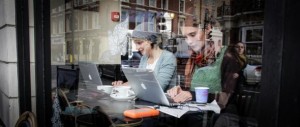Interview: journalism of the future
Everyone agrees that journalism is undergoing radical changes. But many questions still remain unanswered about what direction it’s taking. How will stories be told differently in a multimedial future? How will research change as social media, crowd-sourcing and data-driven journalism open up new sources of information? And importantly, how will journalists earn a living as ever increasing numbers of people consume their news online? German journalists Caterina Lobenstein and Amrai Coen sought answers to these burning questions by visiting journalists, bloggers and activists on a whirlwind trip around the world. DW Akademie’s Kate Hairsine talked to Caterina Lobenstein about the search for the journalism of the future.
Together you both interviewed nearly twenty people in seven cities – Cairo, Sao Paolo, Mumbai, London, New York, Tokyo and Hamburg. How did you decide who you wanted to talk to?
We deliberated about how we could best find the answers to the questions that continually came up when we thought about journalism going digital. In the end, we always came back to the same three questions.
And those questions were?
As journalism goes digital, how does this change how stories are told because you can tell an online story in a completely different way to a print article or television report? Then we asked ourselves how research is going to change when you suddenly have access to enormous amounts of data as well as the possibility of conducting research together with many other people. And the third question was the financial question, how can journalists continue to make money when newspapers aren’t printed on paper anymore but rather on the Internet? Then we wrote down the names of people who we found inspirational and projects which we thought were pioneering in the field. For example, Brian Storm, the founder of MediaStorm, is a multimedia producer from Brooklyn who we have always admired. He produces fantastic online multimedia documentaries.
Watch their interview with Brian Storm (in English)
Another example is ProPublica. It’s also in New York and it is probably the most well-known example of non-profit investigative journalism today. (Watch their interview with Stephen Engelberg from ProPublica here)
We also asked ourselves what developments had influenced us as journalists here in Germany in the past two or three years. One event was the Japanese tsunami catastrophe in 2011 when newspaper sales plummeted. Normally, when there is a catastrophe, sales soar because people want information. But this time sales dropped because people were getting their news from the Internet instead. An increasing number of people who weren’t journalists were reporting online, for example, video bloggers were going out with small cameras and blogging about the tragedy. We met with one of them in Japan.
Caterina and Amrai met with video blogger Richi Miyakawa (watch their interview with him in English). On their blog, they wrote that when they first watched Richi’s videos, they were embarrassed for him because they thought the videos were emotional and too subjective. When they met Richi though, and he talked about how he felt about the supposed ‘objectivity’ of journalists reporting on the tsunami, Caterina and Amrai were embarassed by their initial attitude.
And then of course, there was the Arab Spring which completely changed the way in which political events are covered. That is why we absolutely wanted to go to Cairo because people who originally weren’t journalists just went out with their phones and documented the protests. We wanted to meet with some of these people.
What surprises did you encounter on your six week journey?
There were several. One of them was in Mumbai. India isn’t going through a print media crisis so it is in a very different situation to many European countries or to the United States in that newspaper sales are skyrocketing. Despite this, the digital scene is developing rapidly and there are journalists who are quite deliberately choosing to work for online media because that is where many exciting things are happening. I found it very interesting that print and online were developing simultaneously.
And what else surprised you?
What really positively surprised me was the conversation we had in London with Simon Rogers from the Guardian (listen to Caterina’s and Amrai’s short interview with Simon Rogers). We talked about which opportunities open up when you don’t work alone as a journalist any more – in the sense that the journalist no longer publishes information as a type of monologue but rather has a dialogue with the readers. I know from my own work that it can be extremely stimulating to reply to reader’s comments and start a conversation. But this interaction with the readers can sometimes be taxing especially when they post comments anonymously. Simon Rogers has created the Guardian’s Datablog where he puts up larger research projects that he works on together with his readers. I was impressed that something like that can actually work so well. (Note – Simon Rogers has since left the Guardian to take up a job with Twitter as its first Data Editor. You can follow him on his blog or on twitter.)
What project inspired you the most on your travels?
One I found particularly exciting was a citizen’s journalism project in Sao Paolo that is really successful. The newspaper, Folha de Sao Paulo, is one of the biggest papers in Brazil. And it now employs citizen journalists from the favelas, which is a part of the city that virtually no journalists enter. The idea is working fantastically well and producing high-quality content. We talked to one of the paper’s bloggers, Leandro Machado, who comes from the favelas (you can watch their report on Leandro in Portugese here). He blogs about his surroundings without writing just for effect. Rather, he is someone who very honestly tries to make visible what is otherwise a blind spot for the newspaper’s readers.
Were your three questions answered at the end of the trip?
It felt as if we collected many tiny mosaic pieces on our trip. We met many people who said that in the next 10 to 20 years, they didn’t believe journalism would be so dependent on large media organisation but instead it would involve many more smaller players. They believed that the media landscape would become more fragmented and heterogeneous. That’s why we didn’t discover just one solution: that is how you make money or that is how you can best research. But we did find personal financial models, different research tools and story-telling strategies that we weren’t aware of before. And the great thing is that there are people out there who are doing these things and showing that it can work, that there are people who are courageous enough to escape from the classical structures of journalism. That was the most valuable thing we learned – that even when many of the newspapers have disappeared, other opportunities can turn up.
Were both of you quite optimistic when you returned from your trip?
I felt inspired. And this feeling of inspiration was stronger than the feeling of dismay I sometimes feel when I wonder how I am going to make a living as a journalist in the future. I would call thata optimism. In Cairo we spoke with freelance journalist Kristin Jankowski. She was very optimistic that journalists, and above all, freelance journalists will built networks that span the world. And she is a good example of this with her Arab Spring Collective (an independent collective of writers, bloggers, video-makers and photographers throughout the Arab countries). She says that the networking possibilities provided by the Internet will allow reporters to research together across boundaries.
You said at the beginning of the interview that many of those who started out as citizen journalists during Arab Spring have now become professionals. Is that a trend?
I think if you are an individual posting information on the Internet, you run the danger of not being heard. In Cairo, you can see what happens when individuals come together. For example, there is a project called Mosireen that is a collective of video bloggers. They are now being used as a research source by the New York Times, the Washington Post and other large media organisations. I don’t know if this is a trend, but it is an excellent way to distribute information, especially in countries without a free press.
Watch Mosireen’s video about what they do.
The multimedia project to explore the future of journalism was initiated by the Chancellery of Hamburg and was put online as part of the Next Media blog. You can view the whole of the Next Media Report here. The texts are in German but several of the videos are in English.
 After beginning her journalism career in German public radio, Caterina Lobenstein discovered the joys of writing and moved to print. She writes for the highly regarded German weekly, Die Zeit, as well as other publications. In 2012, Medium Magazin featured her (along with her colleague Amrin Coen) as one of the the “Top 30 Under 30” most talented young journalists in Germany, Austria and Switzerland.
After beginning her journalism career in German public radio, Caterina Lobenstein discovered the joys of writing and moved to print. She writes for the highly regarded German weekly, Die Zeit, as well as other publications. In 2012, Medium Magazin featured her (along with her colleague Amrin Coen) as one of the the “Top 30 Under 30” most talented young journalists in Germany, Austria and Switzerland.





Feedback